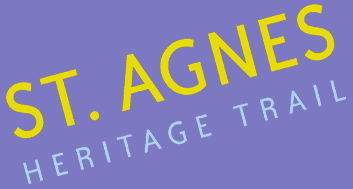
Walk 7 - Wheal Coates, Chapel Porth, Wheal Lawrence Valley and Goonvrea
Towanroath Shaft
 Find the steps at the left-hand side of the main engine-house and follow the path which leads to the
lower cliff path, Towanroath shaft and the pumping engine-house. This shaft drops into the back of a
cave which at low spring tides can be entered from the beach C. Walk a few metres along the path
towards the west. If you look South-west along the coast you will see the inlets at Porthtowan and
Portreath. Further still are North Cliffs and Godrevy Lighthouse on its island, the inspiration for Virginia
Woolf's "To the Lighthouse". Behind Godrevy is the curve of St. Ives Bay. In the other direction, the nearest
headland is Tubby's Point, where a "kitchen midden" (heap) of shells suggests how important seafood was
in the local diet of prehistoric times. Between Tubby's Point and St Agnes Head, Mesolithic flint flakes and
scrapers can still be found providing further evidence of early human activity in the area.
Find the steps at the left-hand side of the main engine-house and follow the path which leads to the
lower cliff path, Towanroath shaft and the pumping engine-house. This shaft drops into the back of a
cave which at low spring tides can be entered from the beach C. Walk a few metres along the path
towards the west. If you look South-west along the coast you will see the inlets at Porthtowan and
Portreath. Further still are North Cliffs and Godrevy Lighthouse on its island, the inspiration for Virginia
Woolf's "To the Lighthouse". Behind Godrevy is the curve of St. Ives Bay. In the other direction, the nearest
headland is Tubby's Point, where a "kitchen midden" (heap) of shells suggests how important seafood was
in the local diet of prehistoric times. Between Tubby's Point and St Agnes Head, Mesolithic flint flakes and
scrapers can still be found providing further evidence of early human activity in the area.
Towanroath to White Rocks
 Walk along the path west from the engine-house, checking occasionally for movement in or above the
sea. If the latter is calm enough and the tide is full, you may be lucky and see one or more seals fishing or
"bottling" (hanging in the water with their heads just above the surface) D. And if you are particularly
fortunate, you might see a school of
dolphins, or in the summer, even a huge
and harmless basking shark cruising past.
Walk along the path west from the engine-house, checking occasionally for movement in or above the
sea. If the latter is calm enough and the tide is full, you may be lucky and see one or more seals fishing or
"bottling" (hanging in the water with their heads just above the surface) D. And if you are particularly
fortunate, you might see a school of
dolphins, or in the summer, even a huge
and harmless basking shark cruising past.
Birds are always present. In late summer the local jackdaws and pipits are joined on the heathland by migrating wheatears which often run along the paths. At any time of year you are likely to see a kestrel hovering above the cliffs; peregrine falcons also come hunting from their breeding site a couple of miles away. As well as herring gulls, blackback gulls, kittiwakes and fulmars frequent this stretch of coast. shags and cormorants and flocks of oyster-catchers may also be seen flying low over the water. The most spectacular display however is provided by gannets which plummet from a great height on to unsuspecting fish. As you walk towards Chapel Porth look carefully at the edge of the path nearest to the sea. Among the thrift, wild carrot and heather, you'll see a low-growing plant with dark green leathery leaves; this is madder, the roots of which were traditionally used to produce a pink dye.
 Walk 1 - St.Agnes Village Trail
Walk 1 - St.Agnes Village Trail Walk 2 - St Agnes Beacon
Walk 2 - St Agnes Beacon Walk 3 - Porthtowan, Banns Vale, Mount Hawke and Chapel Porth
Walk 3 - Porthtowan, Banns Vale, Mount Hawke and Chapel Porth Walk 4 - Wheal Rose, The Poldice Plateway and Mawla
Walk 4 - Wheal Rose, The Poldice Plateway and Mawla Walk 5 - Mount Hawke
Walk 5 - Mount Hawke Walk 6 - Mithian
Walk 6 - Mithian Walk 7 - Wheal Coates, Chapel Porth, Wheal Lawrence Valley and Goonvrea
Walk 7 - Wheal Coates, Chapel Porth, Wheal Lawrence Valley and Goonvrea Walk 8 - Water Lane, Wheal Butson and Jericho Valley
Walk 8 - Water Lane, Wheal Butson and Jericho Valley Walk 9 - Jericho Valley and Cross Coombe
Walk 9 - Jericho Valley and Cross Coombe Walk 10 - Blackwater
Walk 10 - Blackwater
